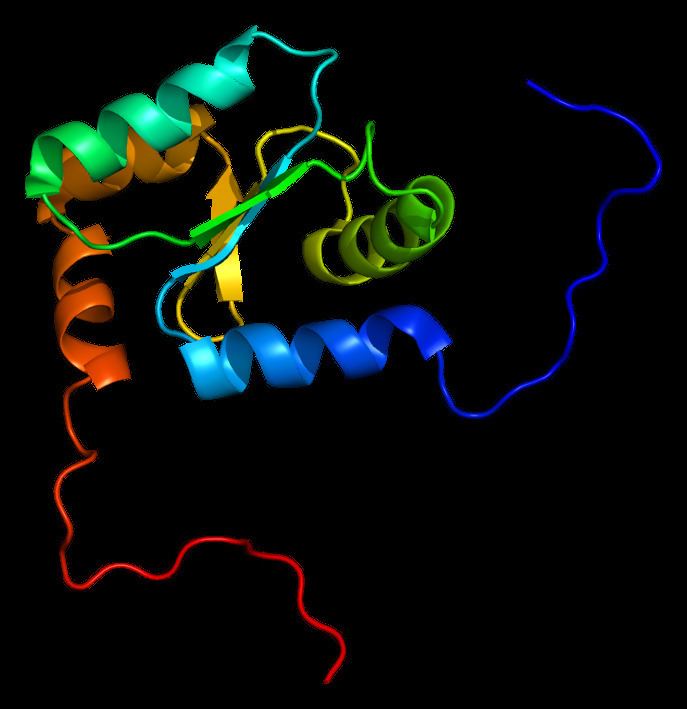Entrez 51022 | Ensembl ENSG00000023572 | |
 | ||
External IDs MGI: 1916617 HomoloGene: 41098 GeneCards: GLRX2 | ||
Glutaredoxin 2 (GLRX2) is an enzyme that in humans encoded by the GLRX2 gene. GLRX2, also known as GRX2, is a glutaredoxin family protein and a thiol-disulfide oxidoreductase that maintains cellular thiol homeostasis. This gene consists of four exons and three introns, spanned 10 kilobase pairs, and localized to chromosome 1q31.2–31.3.
Contents
Alternative splicing of GLRX2 leads to three isoforms of Grx2. One isoform, Grx2a, localizes to the mitochondria, is ubiquitously expressed in tissues (e.g. heart, skeletal muscle, kidney, and liver), regulates mitochondrial redox homeostasis, and protects cells against oxidative stress. Isoforms Grx2b and Grx2c, both localized to the nucleus and cytosol, are expressed only in testes and cancer cell lines and facilitate cellular differentiation and transformation, potentially inducing tumor progression.
Gene
The transcripts of mitochondrial and nuclear Grx2 isoforms, Grx2a and Grx2b, respectively, differ in the first exon, with the exon 1 in Grx2b located upstream of that in Grx2a. Grx2c is derived from alternative splicing of the Grx2b transcript with a shorter exon 1 than that of Grx2b.
Protein
As a GRX family protein, Grx2 has an N-terminal thioredoxin domain, possessing a 37CSYC40 active site motif with a serine residue replacing the conserved proline residue. This amino acid substitution allows the main chain of Grx2 to be more flexible, promoting coordination of the iron-sulfur cluster and facilitating deglutathionylation by enhanced glutathione-binding. The cysteine pair (Cys28, Cys113) falls outside of the active site, and it is completely conserved in Grx2 proteins but not found in some other GRX family proteins (i.e. Grx1 and Grx5). A disulfide bond between this cysteine pair increases structural stability and provides resistance to over-oxidation induced enzymatic inactivation.
Function
Grx2 functions as a part of the cellular redox signaling pathway and antioxidant defense mechanism. As a GRX family protein, Grx2 acts as an electron donor to deglutathionylate proteins. It has also been shown to reduce both thioredoxin 2 and thioredoxin 1 and protects cells from apoptosis induced by auranofin and 4-hydroxynonenal. Grx2 is also an electron acceptor. It can catalyze the reversible oxidation and glutathionylation of mitochondrial membrane thiol proteins. Additionally, NADPH and thioredoxin reductase efficiently reduce both the active site disulfide of Grx2 and the GSH-Grx2 intermediate formed in the reduction of glutathionylated substrates.
Enzymatic activity of Grx2 leads to its role in regulating redox-induced apoptosis. Grx2 over-expression protects cells against H2O2-induced damage while Grx2 knockdown showed the opposite effect. The protection role of Grx2 against H2O2-induced apoptosis is likely associated with its ability to preserve the electron transport chain complex I. In addition to H2O2, Grx2a overexpression is resistant to apoptosis induced by other oxidative stress reagents (i.e., doxorubicin (Dox) and phenylarsine oxide), due to reduced cardiolipin oxidation and subsequent cytochrome c release. Interesting, Grx2 has also been found to prevent aggregation of mutant SOD1 in mitochondria and abolish its toxicity.
Being a redox sensor, Grx2 activity is tightly regulated by the oxidative state of the environment via iron-sulfur cluster. In steady state, Grx2 forms dimers to coordinate iron-sulfur clusters, which in turn inactivate Grx2’s activity by sequestering the active-site cysteines. During oxidative stress, the dimers separate into iron-free active monomers, which restore Grx2’s activity.
Clinical significance
From 42 cases of non-small cell lung cancer patients, the expression level of Grx2 showed a significant correlation with the degree of differentiation in adenocarcinoma and a clear inverse correlation with proliferation. In tumor cells, cells with decreased Grx2 are dramatically sensitized to cell death induced by the anti-cancer drug, DOX.
In cardiovascular disease, Grx2a overexpression protects mouse heart from Dox and ischemia-induced cardiac injury, potentially via increasing mitochondrial protein glutathionylation. Conversely, Grx2 knockout hearts developed left ventricular hypertrophy and fibrosis, leading to hypertension. The mechanistic study shows that Grx2 knockout decreased mitochondrial ATP production, possibly via increased glutathionylation and thereby inhibition of complex I.
Interactions
Grx2 has been shown to physically interact with MDH2, PITPNB, GPX4, CYCS, BAG3, and TXNRD1 in one independent high-throughput proteomic analysis.
